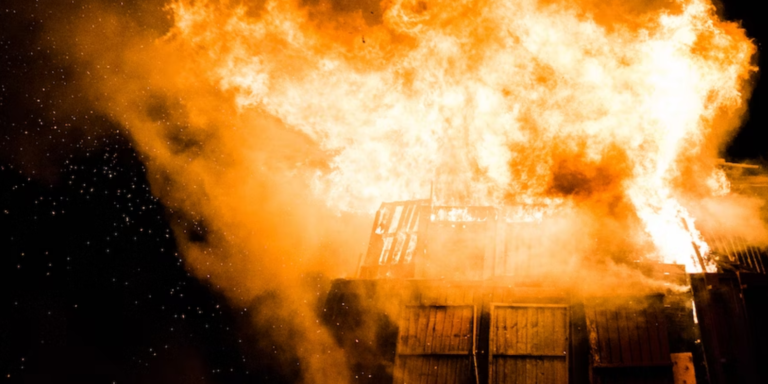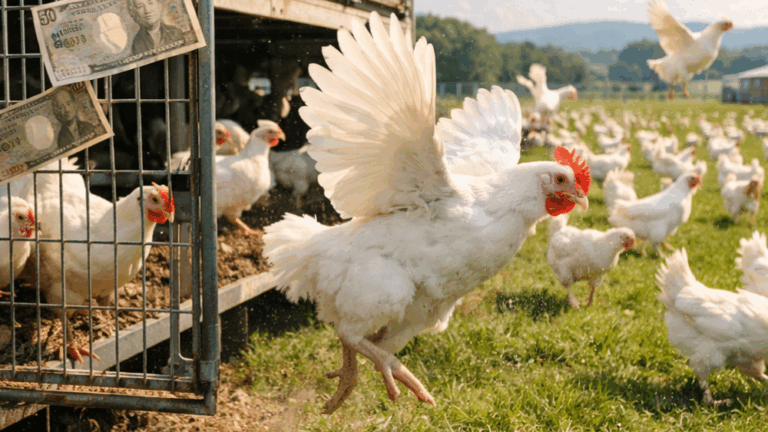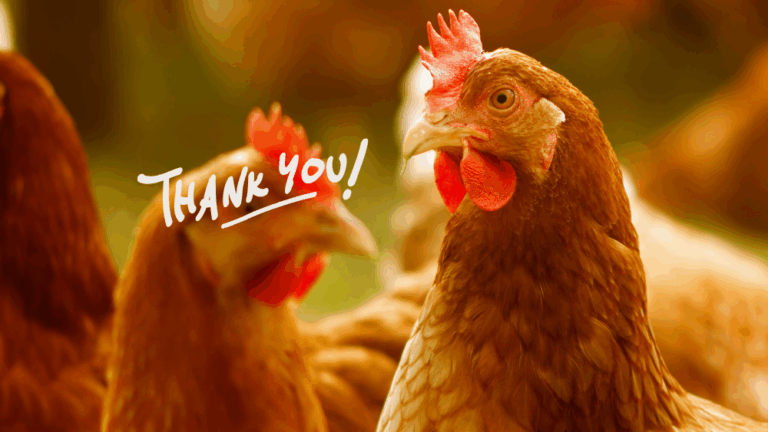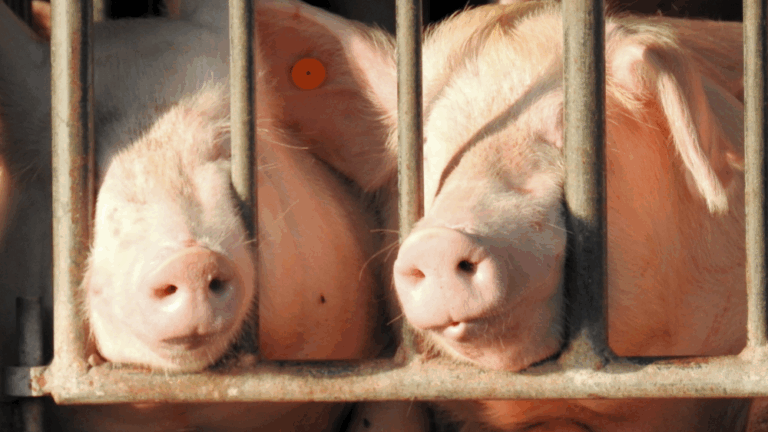April 26th in 2023, a large farm housing 150,000 chicken hens died in a barn fire in Omitama, Ibaraki prefecture. No single chicken survived. They were stuck in their cages, waiting to die in fire. Just imagine their fear and agony.
When you take a look at the media coverage, they report as though it was a relief since no humans died. No one reported what actually happened although the police and the fire stations were investigating this case so we inquired about this about 8 years ago. One fire station answered that they didn’t have any record since fires in farm houses were usually regarded as trivial. The newspaper said they also wanted to know the cause while the police made no comments since it was something about“personal information”
Every time we hear about these fire incidents, we think of animals who must have died while being trapped while fire was approaching them just like those animals helplessly killed by the Great East Japan earthquake in 2011.
The Fire and Disaster Agency released a report of causes of the fires from 2017 through 2019. Though the document was nothing official since it was used for a special committee, there is some revealing information we should take a close look at.
The Number of Animal Farm Fires
In 2019
- Burned down:58 (50%)
- Half destroyed :12 (10%)
- Partially destroyed :28 (24%)
- Small fires:14 (12%)
- Others:4 (3%)
- Total:116 cases
In 2018
- Burned down:45 (45%)
- Half destroyed :13 (13%)
- Partially destroyed :29 (29%)
- Small fires:13 (13%)
- Others:0
- Total:100 cases
In 2017
- Burned down:52 (50%)
- Half destroyed :13 (12%)
- Partially destroyed :25 (24%)
- Small fires:13 (12%)
- Others:2 (2%)
- Total:105 cases
Causes of Fires
In 2019
- Electrical Wires such as phones: 12 (10.3%)
- Bonfires: 10 (8.6%)
- Electrical equipment: 7 (6.0%)
- Electrical devices: 6 (5.2%)
- Gas stoves; 5 (4.3%)
- Welding machines・Cutting machines: 5 (4.3%)
- Stoves: 4 (3.4%)
- Burning: 3 (2.6%)
- Lighting: 3 (2.6%)
- Arson: 2 (1.7%)
- Wiring accessory: 2 (1.7%)
- Wiring in Transportation: 2 (1.7%)
- Incinerator: 2 (1.7%)
- Ashes: 2 (1.7%)
- Total:65 cases *discrepancy by 51 cases
In 2018
- Electrical Wires such as phones: 13 (13%)
- Wiring accessory: 7 (7.0%)
- Bonfires: 6 (6.0%)
- Stoves: 6 (6.0%)
- Electrical equipment: 4 (4.0%)
- Exhaust pipes: 4 (4.0%)
- Electrical device: 3 (3.0%)
- Arson: 2 (2.0%)
- Gas stoves: 2 (2.0%)
- Lighting: 2 (2.0%)
- Welding machine・Cutting machine: 2 (2.0%)
- Total:51 cases *discrepancy by 49 cases
In 2017
- Electrical Wires such as phones: 14 (13.3%)
- Electrical device: 7 (7.6%)
- Bonfires: 7 (6.7%)
- Stoves: 7 (6.7%)
- Wiring accessory: 7 (6.7%)
- Welding machine・Cutting machine: 4 (3.8%)
- Lighting: 3 (2.9%)
- Smoking: 2 (1.9%)
- Suspicion of Arson 1 (1.0%)
- Playing with fire: 1 (1.0%)
- Sparks: 1 (1.0)
- Total:54 cases *discrepancy by 51 cases
*Discrepancies were caused since some causes were unidentifiable
Among all of these causes, “arson” is the only thing that would have been hard to prevent. Reportedly, disgruntled former employees or neighbors can become arsonists while others just arson for insurance money; they just ignore animals’ lives, either way.
You may think some fires may be caused by heating systems set for animals. However, that rarely happens. Most of the fires are caused by the lack of human’s attention. One employee at a broiler farm shared his experience. Their security company would inform employees when they detect high temperatures at the farm without knowing what the cause was. When the anomaly happened at night while no employees were working, it was too late to do anything but watch the house burning.
Fires in Animal Farms
As of April in 2023, there have been numerous cases of animal farm fires since the beginning of this year as below:
- On January 12th – 600 pigs died in farm in Miyajkonoshiro city
- On January 15th – 18,000 chickens died as two chicken houses burned down in Handa city of Aichi
- On January 19th – A man got burned while putting out fire in a chicken farm in Kijo machi
- On February 11th – A cattle barn burned down in Hamanaka
- On February 15th – A cattle barn burned down in Kobe. More than 10 cattle and dairy cows were confirmed dead
- On March 6th – More than 30 dairy cows were killed in fire in a cattle barn of Gosen city
- On March 7th – 4 cattle are dead in cattle barn fire in Omitama, Ibaraki
- On March 9th – A chicken house burned down in Satsumasendai. 10,000 chickens died in fire
- On March 14th – 800 pigs were killed by fire in a barn in Asahi city of Chiba
- On March 18th – 50 dairy cows and cattle died in fire in Toyotomi
- On March 27th – A cattle barn burned down in Iizunamachi, Nagano. At least 8 cows were dead
- On March 31st – “Burning cattle feed”says the report, fires in numerous areas in Chizu, Tottori
- On April 6th – “There are cows inside.”30 dairy cows were killed. No one was hurt
- On April 9th – A cattle barn got fire in Tochigi
- On April 22nd – A cattle barn burned down in Midori city of Gunma
- On April 26th – A chicken house burned down in Ibaraki. 150,000 birds were killed. No one was hurt
Just a single fire can kill tens of thousands since so many chickens are confined in one tiny place. According to the report issued by the Animal Welfare Institute in Washington DC, of the nearly 3 million farm animals killed in barn fires during the time period studied, nearly 98% were poultry. Another data shows that out of all 6.5 million animals killed in fire,92 % were poultry followed by 2% of pigs and less than 1% being cows. If Japan had similar data, it’s easy to assume it would look similar to these numbers since the majority of victims are usually poultry in this country as well.
In fact, even with the above reports alone, chicken accounts for 99.1%, pigs 0.7%, and cow less than 0.1%. Cows sometimes manage to escape if they aren’t tethered. On the other hand, chickens are usually put in battery cages where there is little space to move in or chicken houses with no windows. This leads to a higher death rate in case of fires. Even if a fire is detected in an early stage, staff are unlikely to save these chickens so most chicken houses are completely burned down when fires occur.

Many lives exist in those animal farms. Fires in animal houses are not natural disasters; they’re caused by human errors. If an employer thinks it’s ok for animals to die in fire incidents, he shouldn’t be qualified for this job and the business should close immediately.
These fires are also a matter of animal welfare issues. The only way we can ensure protecting animals is to prevent fires from happening. However, the situation is only getting worse in Japan.
As the Act on Special Provisions for building livestock sheds and their usage was passed, the Standards of fire defense equipment at livestock sheds became effective as of April 1st in 2022. We are including the Standards in the following chapter.
Livestock sheds, milk collection and milking facilities, and manure storages
1) It is not detrimental from the viewpoint of fire prevention and evacuation (examples: single storied buildings, multi-purpose facilities) 2) When there is no object from the viewpoint of prevention of the spread of fire (example: No buildings or objects within 6 meters), the special standards about fire prevention measures may apply. The standards are as follows:
i) Fire extinguishers must be placed every 20 meters in a place that’s larger than 150 square meters. However, this does not apply for livestock facilities or manure facilities
ii) Fire hydrants inside and outside the building: Not necessary
iii) Fire alarms: Not necessary *Fire alarms are needed if there is a room for administrative work that is larger than 1,000 square meters. That said, no alarms are needed for animal facilities.
iv) Evacuation facilities: Not necessary *No need to set evacuation lights should there be windows or exits
v) facilities necessary for fire: Not necessary in an area that is smaller than 20,000 square meters. * Not needed in a single-storied building that is lower than 16 meters and is not made of wood, if a total area is smaller than 10,000 square meters
Warehouses, garages for vehicles, and parking lots
1) Fire extinguishers must be placed every 20 meters in a place that’s larger than 150 square meters.
2) Fire hydrants: Not necessary for an area that is larger than 700 square meters for warehouses. In the case of a garage for vehicles or parking lots, no fire hydrants are needed. If the area is smaller than 3,000 square meters, no fire hydrants are needed outside.
3) Special fire equipments: Not needed if the floor is smaller than 500 square meters
4) Alarm system: Not necessary if an area is smaller than 500 square meters
5) Evacuation facilities: Not necessary *No need to set evacuation lights should there be windows or exits
6) Fire facilities necessary for fire: Not necessary in an area that is smaller than 20,000 square meters.
It’s hard to believe when they say there’s no need to implement fire prevention measures while the animal facilities are full of reasons to catch fires. Ironically, this Act was put in place in order for Japan to compete in the agriculture field in the global market where animal welfare is so important.
There’s not much we can do when a fire starts; we are helpless when it comes to dealing with big fires. That is exactly why people in the agribusiness industry must have fire prevention measures. We should also send our opinions to the Ministry of Agriculture as civilians to voice against this unmerciful Act.
In the last section, we will share causes of fire in animal farms and our ideas of how to prevent them.
Causes of the fire and prevention measures
In order for fires to start, it requires oxygen, fuel, and heat, which are called fire triangles. Animal farms have all of the three as there’s 1) ventilation (oxygen), 2) combustible (fuel), and lighting (heat). We can simply tackle each of these to prevent fires.
Cause 1: Issues with lighting and wires
The humidity and gas in animal facilities cause rust in the electric systems which leads to catching fires. It can ignite if there’s some space between terminals due to the rust. Also, rodents like chewing the covers of the wires that can cause fires as well.


Measures
- Daily check-in by employees
- Regular check-in and risk assessments by licenced electricians and fire departments
- Use wires covered by metal
- Use dust proof or moisture prevention covers for lighting
- Detect hot spots using infrared thermal scanner
- Avoid hidden wires such as buried wires
Cause 2: Using heating systems for a long period of time
A number of fires increase during Winter as the usage of heaters and stoves is more frequent. The longer they use such systems, the higher chances of fires they’ll face.
Measures
- Use heating systems following the guidelines provided by the makers
- Avoid using heaters for a long period of time
- Monitor when heaters are being used
- Avoid using damaged heating systems, naked wires, or lights without covers
- Avoid storing heating systems or extension cords in an area animals are kept
- Avoid using extension cords too much
- Use heaters with auto shut-off function
- Place mesh guards under lamps
- Avoid using insulating tape for rusty cords
It’s always a good idea to avoid windowless facilities as well. This way, they can use fewer lighting systems since they use natural lights.
Cause 3: Too many combustibles
Not only are there some items that are easily flammable, the animal houses are usually dusty with spiderwebs and sawdust. These can catch fires any time if the facility isn’t tidied up.
Measures
- Organize the facility both inside and outside
- Reduce the number of flammables that are not necessary to store in the animal facility
- Keep enough distance (at least 1 meter apart) between combustibles and electric systems
- Clean dust and spiderwebs regularly
- Clean fans and motors regularly
- Remove potential flammables such as rubbles and grass
- Avoid using fuel vapors inside the animal facility
- Avoid welding or any work that requires flamethrowers inside the animal facility
- Use fireproof pads on the ground when it’s necessary to use combustibles inside the facility
- Be cautious of sparks around manure pits
You may have been shocked to hear that 18,000 cows were killed by an explosion in a dairy farm in Texas. This sort of desister, however, is surprisingly common as manure management equipment can often get ignited.
Cause 4: Vehicle related problems
Large vehicles such as trucks usually release high heat for a while even after the engine is turned off. They can easily start fires if flammable fragments touch the vehicle.
Measures
- Park vehicles that can retain high heat distant from the animal facility
- Implement a spark prevention device in an exhauster
- Store rag to remove oil in a safe place
- Implement a bollard in a fuel tank to prevent collision
Cause 5: Smoking
Smoking materials are the leading cause of fire in general. From 2017 through 2021, tobacco was the number 1 cause.
Measures
- Prohibit smoking inside the facility
That being said, it is also a fact that a high percentage of employees at animal facilities are smokers. The least we can do is, then, to use ash trays with water.
Cause 6: Hay fires
This may be one of the causes we tend to overlook; hay fires caused by excessive moistures in the process of bacterial reaction. This is surprising to many people since it’s wet hay that is starting fires. Some only think of dairy farms when we say hay, but it’s used in farms keeping sows and chickens overseas. Sawdust is also commonly used in Japan.
Measures
- Store hay in a different building
- Keep the area dry
- Monitor moisture level of hay
Critical temperatures:
65℃:Monitor daily
70℃:Monitor every 4 hours
80℃:Notify fire departments, remove hay from the animal house
85℃:With oxygen, hay may be ignited
100℃:Hay will start fire when reaching this point
We used to use salt in order to prevent hay fires, which has been proven to be least effective.
Dried ice, liquid nitrogen, and CO2 gas can remove oxygen from hay.
Other causes:
- Mishandling electrics
- Abundant heat lamps
- Rusty electrical equipment due to overuse of high pressure washers to clean the place after animals are shipped out
- Bonfires near the animal facilities
- Stoves used for humans
- Coffee makers and other electrical devices
- Hay catching fires from the glass windows reflecting the Sun
- Thunders
Etc.
Measures
- Design electrical systems and equipment that will endure the environment in the animal facilities
- Install a system to prevent or detect electrical abnormality
- Install smoke, carbon monoxide, and heat detection
- Install firewalls and use fire proof materials such as latex paints
- Install sprinklers
- Use LED lights. Place lights far from ceiling
- Eliminate animal facilities in places where temperature gets below freezing
References
https://www.ontario.ca/page/electrical-systems-barns
https://www.ontario.ca/page/electrical-systems-barns
https://www.ontario.ca/page/10-ways-reduce-risk-barn-fire
https://conestogabuildings.com/blog/eight-steps-prevent-barn-fires/#:~:text=COMMON%20CAUSES%20OF%20BARN%20FIRES,and%20electrical%20use%20is%20high
https://www.ponybox.com/news_details.php?id=2804
https://blackburnarch.com/2014/02/03/barn-fires-occurrences-causes-and-prevention/
https://esc.rutgers.edu/fact_sheet/fire-prevention-and-safety-measures-around-the-farm/
https://awionline.org/content/barn-fires
https://www.ontario.ca/page/barn-fires-ontario
https://www.horseillustrated.com/horse-keeping-extinguish-threat-of-barn-fires
https://www.timbercreekfarmer.com/how-to-avoid-a-chicken-coop-fire/
https://www.nadis.org.uk/disease-a-z/pigs/fires-on-the-pig-farm/#:~:text=Accidental.,causes%20of%20pig%20farm%20fires
https://www.hazardexonthenet.net/article/58612/Maine-fire-could-be-latest-in-pig-barn-explosion-epidemic.aspx
https://www.fwi.co.uk/livestock/housing/expert-advice-on-improving-fire-safety-on-your-pig-farm
https://www.brownwoodnews.com/2022/03/31/effects-of-wildfires-on-livestock/
https://www.daikoku-li.co.jp/
https://www.hokende.com/news/blog/entry/2014/10/17/170000
https://hojin.or.jp/agri/post_16-html/
https://www.maff.go.jp/j/council/seisaku/kyosai/bukai/02/pdf/data4.pdf












